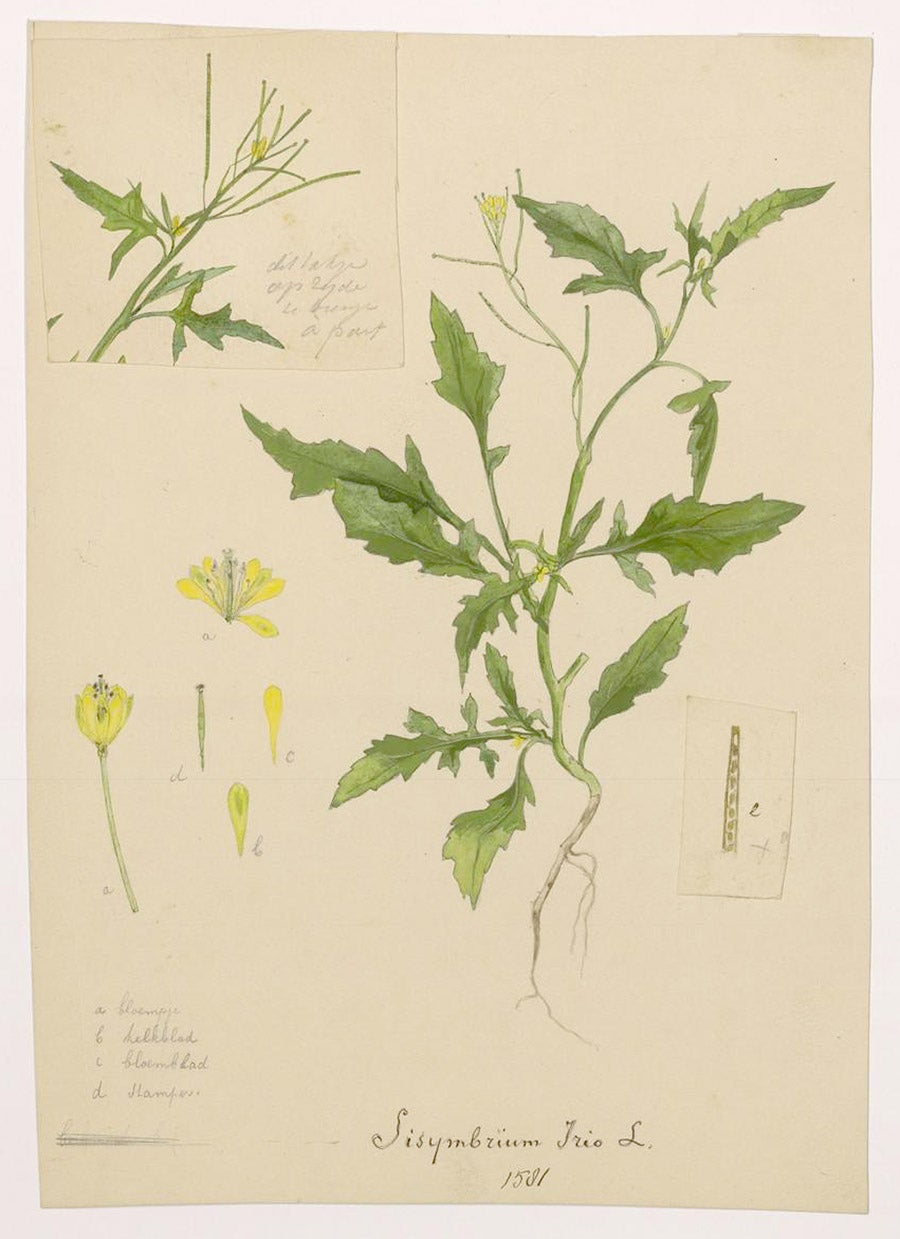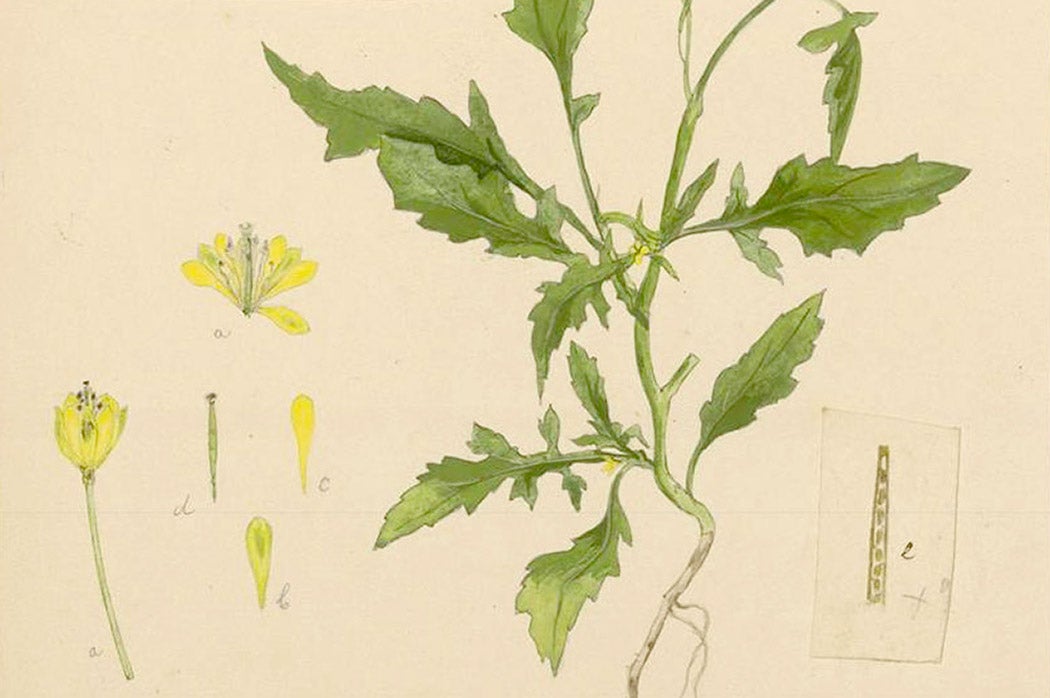Throughout 1667, the ruins of London’s St Paul’s Cathedral became overgrown with a thicket of weeds. One yellow-flowered plant in particular mounted the walls in huge quantities. That spring, on the south side of the church, “it grew as thick as could be; nay, on the very top of the tower,” wrote the antiquary John Aubrey, reminiscing some years later. In September 1666, a terrible fire, beginning in a bakery on “Pudding Lane,” had swept through the city, destroying the homes of thousands. But it also left in its wake apparently fertile ground for plants. Some, like the yellow flower of St Paul’s, had been identified rarely before the Great Fire. So dramatically did this particular plant burst onto the scene that expert botanist and royal physician Robert Morison presumed it had sprung from the ashes themselves. Morison was here calling upon a theory of “spontaneous generation” of life from non-living or decayed material, proposed as early as Aristotle and still popular, as William Keezer explains, in the seventeenth century.

London rocket, or Sisymbrium irio, as it is known today, belongs to the Brassicaceae family, which is home to many culinary staples such as cabbage and broccoli. Unlike its distant kin, edible rocket (Eruca sativa), it’s not usually consumed, though its leaves are similar in shape. Counter to its common name, London rocket can be found from the Mediterranean to East Asia and isn’t generally considered native to Britain, flourishing periodically in the capital perhaps as a result of the city’s “heat island” effect. It’s a species well-suited to disturbed or barren environments and often found in neglected areas such as waste sites, and as such, fulfills many of the traditional criteria for a “weed.”
To call London Rocket a weed is not to suggest that its presence is always unwanted. Undeterred by its misleading epithet, London naturalists such as John Swindells, former President of the London Natural History Society, have keenly traced the plant’s appearance in the city throughout the centuries. It has featured around the Tower of London as a local attraction to naturalists and continues to be considered worthy of protection in the city. It was recently named among the species of note in the Biodiversity Action Plan for Queen Elizabeth Olympic Park. A question then remains, though: why has this non-native weed sustained such intrigue?

The answer surely lies in the plant’s history. For those like Aubrey, writing in the seventeenth century, it grew as a living relic, recalling a destructive force that had transformed the urban landscape, now home to a host of new buildings designed to restore the city’s splendor. This included the St Paul’s we know today, which was designed by Sir Christopher Wren to replace the fire-damaged structure that had stood on Ludgate Hill since the Middle Ages.
Aubrey was among several antiquaries and writers of his era interested in documenting the history of the landscape and people of Britain. Unlike other regions of Europe, notably those preserved by Greek and Roman writers, Britain had few written accounts of its ancient past, and it was in part to remedy this that a surge of interest in archaeology took hold of learned gentlemen. Aubrey, for example, was pioneering in his drawings of Stonehenge. And although today they are two distinct disciplines, for many seventeenth-century writers, the study of plants and the study of antiquities were kindred passions, often combined in works of “chorography,” designed to describe the geography, nature, culture, and history of a region. Aubrey, therefore, saw no difficulty in setting botanical descriptions alongside anecdotes, local legends, personal memories, and architectural and archaeological observations. He gave special attention to the botanical traces of human history. For him, some plants, particularly following the civil wars, seem to foreground a form of continuity or healing following losses of local significance.
For London rocket, this reparative quality was literal. An additional, crossed-out note in one of Aubrey’s manuscripts adds the following to his account of London rocket: it appeared “after the Fire, over all the Ruines,” in such quantities that the inhabitants “thatch[ed] their shedds & cellars with it.” Sisymbrium irio is not a natural thatching material. Common choices included wheat straw or water reed. But it is easy to see, with such extensive repairs in sudden demand, how its great quantity and locality might have compensated for any material deficiencies.

In scholarly accounts of Sisymbirum irio’s written traces, Aubrey’s record has been overshadowed by the plant’s appearance in seminal works by English naturalists Christopher Merret (1666), Robert Morison (1669), and John Ray (1677), which more closely resemble modern botanical surveys. Distinct from the antiquarian “natural histories” described above, these works belong to the genre of natural “catalogues” consisting only of short morphological descriptions of plants, the locations where they had been found, and their names. These notionally complete lists of species belonging to a particular region are forerunners to what we would now term local “floras.” They can be distinguished, in their aim of completeness, from the earlier traditions of herbals, which prioritized plants on the basis of their medicinal value, rarity, or horticultural interest. Catalogues such as Ray’s study plants for their own sake, paving the way, as William Stearn argues, for systems of classification and taxonomy used today.

Despite the clear differences between works of antiquarian “chorography” and species catalogues, such works all demanded the collection of “natural” data from across the landscape and coincided with the beginning of “field botany” as a form of paid labor. In the case of Sisymbrium irio, Aubrey credits his information to one laborer in particular—a man named Thomas Willisel, whose name is scrawled in the margins of the manuscript reproduced above.
Thomas Willisel’s life, recorded by Aubrey, offers a remarkable snapshot of botanical fieldwork in the 1660s, conducted by an enthusiastic few, at times with little funds. Born in poverty, Willisel was first a foot soldier in Oliver Cromwell’s army before entering the employment of Robert Morison as a gardener in St James’s Park (a site that had formerly served as his garrison). In the following years, Willisel collected plants not only for Morison but also for Ray, Merret, and the Royal Society, undertaking great journeys across Britain, carrying little besides his dog and a gun for hunting. He was praised by his contemporaries not only for his sincere enthusiasm and aptitude for botany but for his hardiness and fortitude.
As Albert Koinm explains, not all early naturalists were willing to undertake their own travels for botany. It was necessary, after all, to search over difficult terrain: Ray’s 1670 work includes plants found “in the bogs among the Rushes.” Fieldwork could also pose great dangers. The famous botanist Carl Linnaeus’s Critica Botanica (1737) names a litany of botanists who suffered or perished while searching for plants. This, too, was Thomas Willisel’s fate: he died within a year of traveling to Jamaica in 1675, having been sent there to collect species of the island.
Weekly Newsletter
These keenly sought labors over ruins and through bogs form the backdrop to Sisymbrium irio’s history in British botany, and this backdrop also gives us an insight into the unglamorous joy of fieldwork that still appears to motivate naturalists today. Collecting urban weeds may hold little appeal for some, but for others, it inspires thoughts of humble city rubbish dumps with potential for discovery and a peculiarly local sense of adventure. Speaking in a recent interview, the north London botanist David Bevans, in the same article in which he names London rocket his “favorite London Weed,” recalls the birth of his interest in the natural world:
I remember getting my first views of Rosebay Willowherb and Oxford Ragwort while exploring bombsites in London when I was a kid in the late 1940s. Stranger danger didn’t exist back then and I was free to roam.
As a non-native weed common to brownfield land and rubble, Sisymbirum irio’s presence in London is also a testament to the role of history and culture in overcoming more traditional categories of value in plants, particularly in the context of dominant enthusiasm for “native plants” in recent decades—a phenomenon explored at length by Gert Groening and Joachim Wolschke-Bulmahn. From the seventeenth century to the present, the appearance of Sisybrium irio in London, unremarkable though it may seem, has served as a window to the past. It has been more enduring, in some cases, than stone buildings and monuments and available to city dwellers in the most humble of locations.
If urban populations are prone to “plant blindness,” as James Wandersee and Elisabeth Schussler have argued (i.e., lacking an acute perception of the plants that populate their environment), then perhaps the story of London rocket provides a lesson in how to change this. It is according to this logic that the Plant Humanities Initiative at Dumbarton Oaks is working to craft “Plant Narratives,” weaving together botanical and human history in order to bring the plants around us into sight.
Editor’s note: This story has been amended to delete a reference to an egg sandwich.
Support JSTOR Daily! Join our new membership program on Patreon today.








